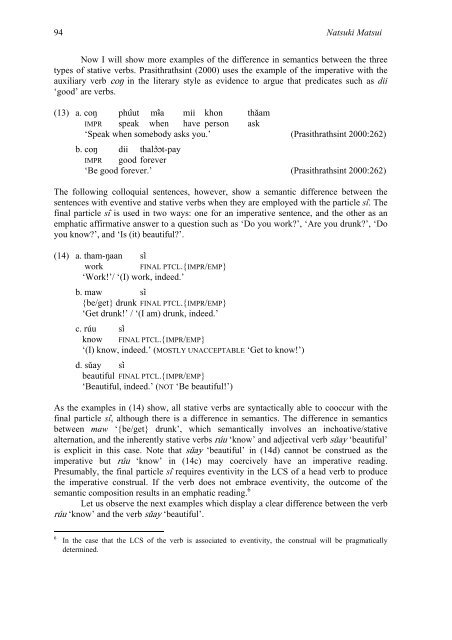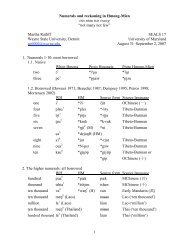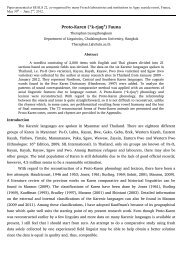proto-southwestern-tai revised: a new reconstruction - seals 22
proto-southwestern-tai revised: a new reconstruction - seals 22
proto-southwestern-tai revised: a new reconstruction - seals 22
Create successful ePaper yourself
Turn your PDF publications into a flip-book with our unique Google optimized e-Paper software.
94 Natsuki Matsui<br />
Now I will show more examples of the difference in semantics between the three<br />
types of stative verbs. Prasithrathsint (2000) uses the example of the imperative with the<br />
auxiliary verb coŋ in the literary style as evidence to argue that predicates such as dii<br />
‘good’ are verbs.<br />
(13) a. coŋ phu�ut mi�a mii khon thǎam<br />
IMPR speak when have person ask<br />
‘Speak when somebody asks you.’ (Prasithrathsint 2000:262)<br />
b. coŋ dii thal���t-pay<br />
IMPR good forever<br />
‘Be good forever.’ (Prasithrathsint 2000:262)<br />
The following colloquial sentences, however, show a semantic difference between the<br />
sentences with eventive and stative verbs when they are employed with the particle si�. The<br />
final particle si� is used in two ways: one for an imperative sentence, and the other as an<br />
emphatic affirmative answer to a question such as ‘Do you work?’, ‘Are you drunk?’, ‘Do<br />
you know?’, and ‘Is (it) beautiful?’.<br />
(14) a. tham-ŋaan si�<br />
work FINAL PTCL.{IMPR/EMP}<br />
‘Work!’/ ‘(I) work, indeed.’<br />
b. maw si�<br />
{be/get} drunk FINAL PTCL.{IMPR/EMP}<br />
‘Get drunk!’ / ‘(I am) drunk, indeed.’<br />
c. rúu si�<br />
know FINAL PTCL.{IMPR/EMP}<br />
‘(I) know, indeed.’ (MOSTLY UNACCEPTABLE ‘Get to know!’)<br />
d. sǔay si�<br />
beautiful FINAL PTCL.{IMPR/EMP}<br />
‘Beautiful, indeed.’ (NOT ‘Be beautiful!’)<br />
As the examples in (14) show, all stative verbs are syntactically able to cooccur with the<br />
final particle si�, although there is a difference in semantics. The difference in semantics<br />
between maw ‘{be/get} drunk’, which semantically involves an inchoative/stative<br />
alternation, and the inherently stative verbs rúu ‘know’ and adjectival verb sǔay ‘beautiful’<br />
is explicit in this case. Note that sǔay ‘beautiful’ in (14d) cannot be construed as the<br />
imperative but rúu ‘know’ in (14c) may coercively have an imperative reading.<br />
Presumably, the final particle si� requires eventivity in the LCS of a head verb to produce<br />
the imperative construal. If the verb does not embrace eventivity, the outcome of the<br />
semantic composition results in an emphatic reading. 6<br />
Let us observe the next examples which display a clear difference between the verb<br />
rúu ‘know’ and the verb sǔay ‘beautiful’.<br />
6<br />
In the case that the LCS of the verb is associated to eventivity, the construal will be pragmatically<br />
determined.





